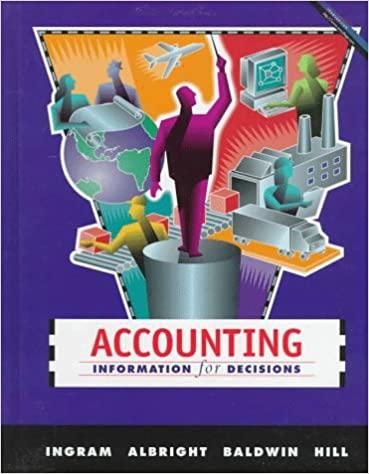Question
Required information Use the following information for the Exercises below. Skip to question [The following information applies to the questions displayed below.] Laker Company reported
Required information
Use the following information for the Exercises below.
Skip to question
[The following information applies to the questions displayed below.] Laker Company reported the following January purchases and sales data for its only product.
| Date | Activities | Units Acquired at Cost | Units sold at Retail | |||||||||||||||
| Jan. | 1 | Beginning inventory | 215 | units | @ | $ | 14.00 | = | $ | 3,010 | ||||||||
| Jan. | 10 | Sales | 165 | units | @ | $ | 23.00 | |||||||||||
| Jan. | 20 | Purchase | 160 | units | @ | $ | 13.00 | = | 2,080 | |||||||||
| Jan. | 25 | Sales | 190 | units | @ | $ | 23.00 | |||||||||||
| Jan. | 30 | Purchase | 330 | units | @ | $ | 12.50 | = | 4,125 | |||||||||
| Totals | 705 | units | $ | 9,215 | 355 | units | ||||||||||||
The Company uses a perpetual inventory system. For specific identification, ending inventory consists of 350 units, where 330 are from the January 30 purchase, 5 are from the January 20 purchase, and 15 are from beginning inventory.
Exercise 5-4 Perpetual: Income effects of inventory methods LO A1
Required: 1. Complete comparative income statements for the month of January for Laker Company for the four inventory methods. Assume expenses are $2,000 and that the applicable income tax rate is 40%. (Round your Intermediate calculations to 2 decimal places.)




Required: 1. Complete comparative income statements for the month of January for Laker Company for the four inventory methods. Assume expenses are $2,000 and that the applicable income tax rate is 40%. (Round your Intermediate calculations to 2 decimal places.) LAKER COMPANY Income Statements For Month Ended January 31 Specific Weighted Identification Average $ 8,165 $ 8,165 $ FIFO LIFO 8,165 $ 8,165 8,165 8,165 8,165 8,165 Sales Cost of goods sold Gross profit Expenses Income before taxes Income tax expense Net income 8,165 8,165 8,165 8,165 8,165 $ 8,165 $ 8,165 8,165 2. Which method yields the highest net income? OLIFO O FIFO Weighted average Specific identification 3. Does net income using weighted average fall between that using FIFO and LIFO? No Yes 4. If costs were rising instead of falling, which method would yield the highest net income? Complete the table to determine the cost assigned to ending inventory and cost of goods sold using specific identification. (Round cost per unit to 2 decimal places.) Specific Identification Available for Sale Cost of Goods Sold Ending Inventory Ending Ending Unit Units Cost Per Purchase Date Activity Units Unit Cost COGS Inventory- Cost Inventory- Sold Units Unit Cost Jan. 1 Beginning inventory 215 Jan. 20 Purchase 160 Jan. 30 Purchase 330 705 $ 0 $ 0 0 Determine the cost assigned to ending inventory and to cost of goods sold using weighted average. (Round cost per unit to 2 decimal places.) Cost per Weighted Average - Perpetual: Goods Purchased # of Date units unit January 1 January 10 # of units sold Cost of Goods Sold Cost per cost of Goods unit Sold Inventory Balance # of units Cost per Inventory unit Balance 215 @ $ 14.00 = $ 3,010.00 January 20 Average cost January 25 January 30 Totals Determine the cost assigned to ending inventory and to cost of goods sold using LIFO. (Round cost per unit to 2 decimal places.) Perpetual LIFO: Goods Purchased # of Cost units per unit Cost of Goods Sold # of units Cost Cost of Goods sold per unit Date Sold Inventory Balance Cost per Inventory # of units unit Balance 215 @ $ 14.00 $ 3,010,00 January 1 January 10 January 20 January 25 January 30 Totals
Step by Step Solution
There are 3 Steps involved in it
Step: 1

Get Instant Access to Expert-Tailored Solutions
See step-by-step solutions with expert insights and AI powered tools for academic success
Step: 2

Step: 3

Ace Your Homework with AI
Get the answers you need in no time with our AI-driven, step-by-step assistance
Get Started


